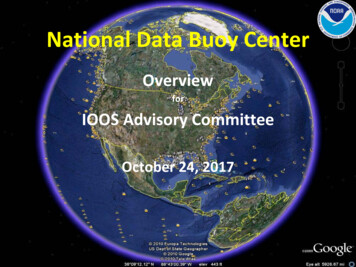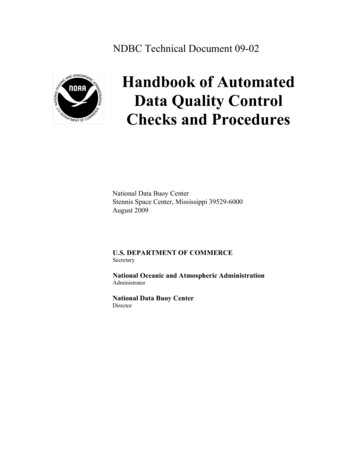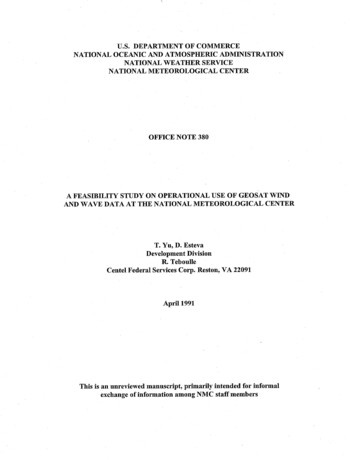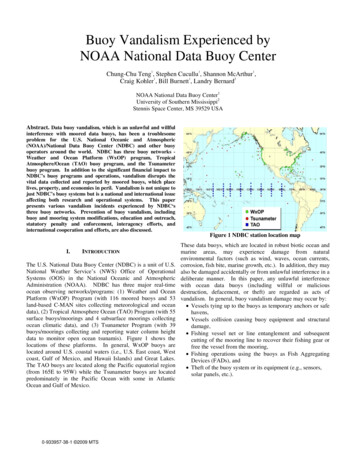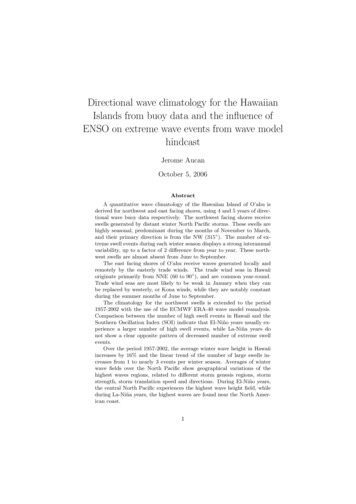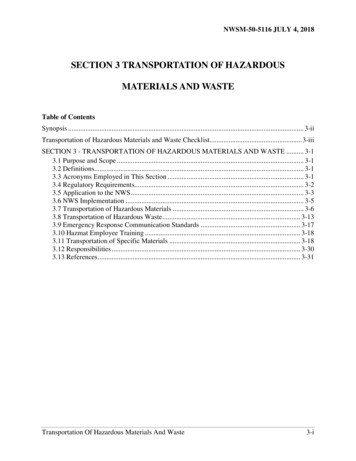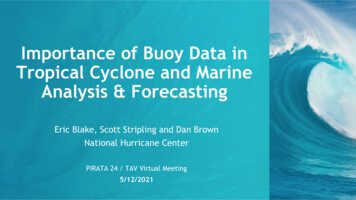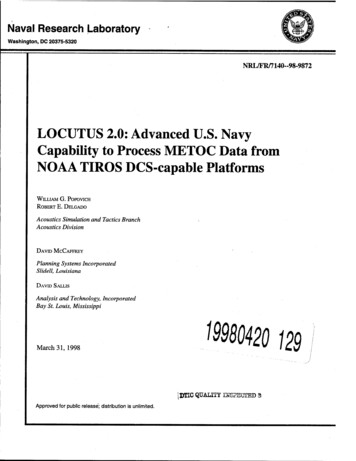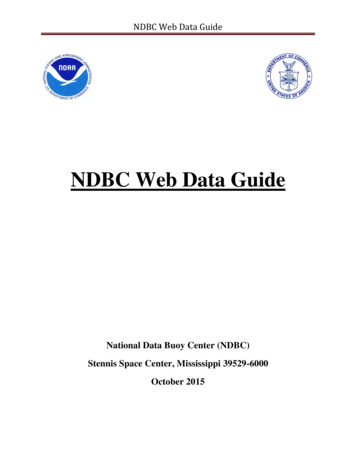
Transcription
NDBC Web Data GuideNDBC Web Data GuideNational Data Buoy Center (NDBC)Stennis Space Center, Mississippi 39529-6000October 2015
NDBC Web Data GuideTable of Contents1.General Guidance. 12.Realtime Data. 13.Latest Observations File. 24.Historical Data & Climatic Summaries. 25.Active Station List . 36.Metadata in XML . 37.NDBC Data Directory. 48.DIF/SOS Services . 49.DODS Services . 510.Tropical Atmosphere Ocean (TAO) Data Download Page. 611.High Frequency (HF) Radar Data Access. 612.DART Data Access . 613.Observation Widget . 714.BuoyCAM Images . 815.Observations by Latitude/Longitude . 916.Ship Observations . 917.Historical Station – User Defined Conditional Search . 918.Feedback . 9Appendix A – File Extension Mapping to Data Types . A-1Appendix B – Subdirectories of www.ndbc.noaa.gov/data .B-1
NDBC Web Data Guide1. General GuidanceThis document provides a high level over view of data available on the NDBC web site(http://www.ndbc.noaa.gov/) to support data consumers. The goal is to assist the user indetermining the best option for obtaining their required data while minimizing the potentialload on the NDBC web farm. We recommend that you review the entire content of thisdocument prior to deciding on your implementation strategy, because NDBC supportsnumerous methods to obtain data from our web site. We highly discourage you fromdeveloping unique processes (i.e. screen scrape mobile page) to obtain our data via othermethods since future development may have a negative impact on your process. We also askthat you consider the frequency of the data updates and limit your data request to conserveour bandwidth and ability to support other users. If after reviewing this document you stillhave concerns in regards to the best method please contact us via the web master e-mailwebmaster.ndbc@noaa.gov and we can provide additional guidance.NDBC currently has FTP services that are available; however, our future plans are todiscontinue these services, therefore, we will not address them in this document. Westrongly recommend that you avoid the use of FTP services when using the NDBC web site.The majority of data posted to the NDBC web server are stored in ascii files that may bedownloaded via HTTP, wget, or Perl/LWP (among other utilities). HTTP is the preferredprotocol.2. Realtime DataThe Realtime directory http://www.ndbc.noaa.gov/data/realtime2/ contains the current (last45 days) data. The term Realtime refers to the version of the data. In general, Realtime dataare the data that have undergone automated quality control checks as they were received inreal time and released on the Global Telecommunications System (GTS). The files are namedstation id.datatype.See appendix A for a listing of the data type extensions and the associated data.As an example, the following files would apply to station 41002, the standard meteorological data is in 41002.txtthe continuous winds data is in 41002.cwindthe spectral wave summary data is in 41002.specthe raw spectral wave data is in 41002.data specetc.Version 1.01
NDBC Web Data GuideIn building file names all alphabetic characters must be in upper case. For instance the CMAN (land) station FPSN7 – Frying Pan Shoals, NC must be entered in uppercase, e.g.,FPSN7.txt.Not all of these data types are available for each station; however, each station has at leastone data type.See Measurement Descriptions and Units for more information on the units of measure usedon the NDBC web site. Samples of each file type are available at the following URL:http://www.ndbc.noaa.gov/mods.shtmlYou can also navigate to this data by selecting a station page and then scrolling down to thebottom and selecting the “Real Time Data” link.3. Latest Observations FileThe latest observation file is available at:http://www.ndbc.noaa.gov/data/latest obs/latest obs.txtThis file contains essentially the same data elements as the standard meteorological data file,however, instead of having the observations from a single station; this file has the mostrecent observation (provided that the observation is less than two hours old) from all stationshosted on the NDBC web site. Since this file has multiple stations it also contains theposition information (latitude and longitude) for each station. The file is relatively small, lessthan 100KB, and is updated approximately every 5 minutes, so it would be a good source ofdata if you are interested in meteorological observations from multiple stations.4. Historical Data & Climatic SummariesThe historical files are available at:http://www.ndbc.noaa.gov/station history.php?station 42040Where the 42040 represents the station that you are interested in.You can also navigate to this page by selecting a station page and then scrolling down to thebottom and selecting the “Historical Data & Climatic Summaries” link.The returned page will have four main sections: Quality Controlled data for the current year – by months Historical Data – by calendar yearVersion 1.02
NDBC Web Data Guide Search historical meteorological data for observations that meet your thresholdconditionsClimatic summary table and plots – by parameter. For details about this informationplease review the description available at:http://www.ndbc.noaa.gov/climatedesc.shtml5. Active Station ListThe Active Station List is available at http://www.ndbc.noaa.gov/activestations.xmlThis file provides metadata in regards to the current deployment for all active stations onthe NDBC web site. The metadata includes station ID, latitude, longitude, station name,station owner, program to which the station belongs, and type of data reported as detailedbelow: met: indicates whether the station has reported meteorological data in the past eighthours (y/n). currents: indicates whether the station has reported water current data in the pasteight hours (y/n). waterquality: indicates whether the station has reported ocean chemistry data in thepast eight hours (y/n). dart: indicates whether the station has reported water column height/tsunami data inthe past 24 hours (y/n).This file is refreshed every five minutes as needed. Note: The main activity that driveschanges are: a service visit, establishment of a new station, or changes in the type of datareceived (i.e. sensor/station failure) therefore, minimal updates would be expected in a 24hour period.Note, the TAO entries do not include the data type attributes (met, currents, water quality anddart) but do include a seq attribute for syncing access to the TAO web site. The TAO array isthe climate stations in the equatorial Pacific.6. Metadata in XMLThe metadata in XML is available ta.xmlThe supporting XML schema can be found ta.xsdVersion 1.03
NDBC Web Data GuideThis file contains the historical metadata back to 2000 for all stations on the NDBCwebsite. Limited metadata is available for non-NDBC stations. The file is generated oncedaily at midnight U.S. Central Time (05:00 UTC during daylight saving time or 06:00 UTCduring standard time).Note: this file is fairly new and there were some inconsistencies in our older metadata, so thisfile is not 100% accurate, however, it is the best representation of the station history from ourperspective.7. NDBC Data DirectoryThe most important files from this directory have already been covered in depth in previoussections; however, this section gives you a broad overview of all the files available under thedata directory available at: http://www.ndbc.noaa.gov/data/See Appendix B for a listing of the subdirectories under the Data directory.8. DIF/SOS ServicesThe NDBC Sensor Observation Service (SOS) is an implementation of the Open GeospatialConsortium (OGC) SOS 1.0 specification that supports the Core Operations Profile. Anoverview is available at: http://sdf.ndbc.noaa.gov/sos/. An interactive demonstration isavailable at: http://sdf.ndbc.noaa.gov/. The actual service is available at:http://sdf.ndbc.noaa.gov/sos/server.php . This service provides an API for accessingobservation data for the following measurements: Air TemperatureConductivityCurrentsSalinitySea Level PressureWater LevelWater TemperatureWavesWindsThese data may be returned in the following formats: comma-separated values (CSV)tab-separated values (TSV)KML/JSON (experimental)OGC Sensor Web Enablement (SWE) 1.0 using the IOOS templateNDBC also supports a GML response, but its use is discouraged as it will be discontinued ina future update. SOS is intended to support machine to machine interface, without humanVersion 1.04
NDBC Web Data Guideintervention. One of the limitations of the current NDBC implementation is that you can onlyrequest one data type per request. However, you can make multiple calls to obtain allobservations. This lack of multiple observed properties and higher complexity queries are alimitation to its current use. However, if you are interested in a single or limited data types(i.e. water level/Tsunami) then SOS maybe a good fit.9. DODS ServicesThe NDBC Distributed Oceanographic Data System (DODS) makes netCDF files availableto the science community and general public via our website. It uses the Open SourceProject for a Network Data Access Protocol (OPeNDAP) software for data providers to sharedata with each other and the end users. This service is available at the following URL:http://dods.ndbc.noaa.gov/The following provides a high level overview of the directory structure/data types availablevia the NDBC DODS server: Version 1.0All NDBC Data NDBC Data adcp – Acoustic Doppler Current Profiler Data contains depth, direction andspeed adcp2 –Acoustic Doppler Current Profiler Data with additional QCinformation primarily from Gulf of Mexico oil rigs. cwind – Continuous Winds data dart – Deep-ocean Assessment and Reporting of Tsunamis data eval – DO NOT USE - Unofficial data mbcurr – Marsh-McBirney Current Measurements data ocean – Oceanographic data oceansites – see OceanSITES Data directory below. pwind – Peak Winds data stdmet – Standard Meteorological data swden – Spectral Wave Density data with Spectral Wave Direction data tao-adcp - see “NDBC TAO Data” directory below. tao-ctd - see “NDBC TAO Data” directory below. wlevel – Water Level data (tide) measured from a non-DART NDBC stationNDBC TAO Buoy Data – The subdirectories are named for each station, based on thelatitude and longitude. For example the station at equator and 110W is namedT0N110W, the station at 2N 110W is named T2N110W. The “T” in the first positionof the file name designates that it is a TAO site.NDBC TAO CTD Data – contains the TAO CTD data collected on servicing cruisesorganized by cruise id. The cruise id consist of a two letter ship id, a two digit fiscal5
NDBC Web Data Guide year, and a sequence number for each cruise performed in support of TAO for thatyear.OceanSITES Data – provides access to OceanSITES data, including TAO. Note theTAO data is the same data as available under the ‘NDBC TAO Data” directoryabove.10. Tropical Atmosphere Ocean (TAO) Data Download PageNDBC recently modified the TAO Data Download page to make it more user friendly. Thenew TAO Data Download is available at:http://tao.ndbc.noaa.gov/tao/data download/search map.shtmlThis data download page provides numerous options for the end user to select: stations, datatypes, start dates, end dates, temporal resolution, file format, etc. This download process islimited to only TAO data from the equatorial Pacific; you cannot get other data hosted on theNDBC web site via this process.11. High Frequency (HF) Radar Data AccessNDBC has the most recent 72 hours of HF radar data available via DODS/THREDDS. Thisservice is available at: http://sdf.ndbc.noaa.gov/thredds/catalog.htmlIn addition to the DODS server HF radar data is available from the main HF radar page at:http://hfradar.ndbc.noaa.gov/. If you scroll down to the bottom of the page the last hyperlink“Tabular Format” will provide observation data in a tab delimited file for the current areadisplayed on the map. If you scroll to the bottom of the second page there is a link to“Download results as text.”12. DART Data AccessYou can retrieve and display a plain text listing of NDBC's historical DART data thatmatches the station ID, starting date, and ending date that you specify. Specify these bymodifying the arguments in this URL http://www.ndbc.noaa.gov/dart data.php?station 46401&startmonth &startday &startyear &endmonth &endday &endyear .The arguments for the station ID and starting and ending dates are specified as follows: station station ID;startmonth starting month (numeric, 1-12);startday starting day (numeric, 1-31);startyear starting year (numeric);endmonth ending month (numeric, 1-12);Version 1.06
NDBC Web Data Guide endday ending day (numeric, 1-31); andendyear ending year (numeric).These arguments may be entered in any order, but all must be given valid values.For example; to retrieve data from station 46401 for January 4, 2004 through January 10,2004; use the following URL:http://www.ndbc.noaa.gov/dart data.php?station 46401&startmonth 1&startday 4&startyear 2004&endmonth 1&endday 10&endyear 2004This will return all water column heights on the NDBC web site for station 46401 from00:00:00 UTC on January 4, 2004 through 23:59:59 UTC on January 10, 2004, inclusive.The output will display the parameters followed by the data. The data includes: date/time of the observation - formatted as "YYYY MM DD hh mm ss" or "2004 01 0401 30 00" for 01:30:00 UTC on January 4, 2004.measurement Type - 1 15 minute measurement; 2 1 minute measurement; 3 15second measurement.water column HEIGHT - The data are recorded in pounds per square inch absolute(PSIA), but are displayed in meters of water after applying a constant 670.0 mm ofwater/PSIA conversion factor.A sample format follows:station 46401startyear 2004startmonth 01startday 18endyear 2004endmonth 01endday 22YYYY MM DD hh mm ss T HEIGHT (meters)2004 01 22 15 00 00 1 5526.8702004 01 22 14 45 00 1 5526.8832004 01 22 14 30 00 1 5526.8962004 01 22 14 15 00 1 5526.9072004 01 22 14 00 00 1 5526.9152004 01 22 13 45 00 1 5526.9172004 01 22 13 30 00 1 5526.91413. Observation WidgetVersion 1.07
NDBC Web Data GuideIf you host a web page and are interested in providing the most recent observation from alimited number of NDBC hosted stations, NDBC provides an Observation Widget thatallows you to easily integrate NDBC observations into your web page.Additional Information is available at: http://www.ndbc.noaa.gov/widgets/Note: This technique only works for web pages in which the user has the ability to pasteHTML content.14. BuoyCAM ImagesNDBC operates BuoyCAMs at several stations. These BuoyCAMs typically take photos onlyduring daylight hours.To view the most recent BuoyCAM image from an NDBC station, use this URL:http://www.ndbc.noaa.gov/buoycam.php?station xxxxxwhere xxxxx is the desired station ID. To see which stations are currently reportingBuoyCAM images, check the BuoyCAMs map.If the server encounters any difficulties in processing your request, you will receive one ofthese error messages: No station specifiedModify your URL to use the station parameter to specify a valid station with aBuoyCAM (station xxxxx where xxxxx is the station ID). Look at the BuoyCAMsmap to see which stations have a BuoyCAM. Invalid station specifiedThe station on the URL is not a valid station. Review the BuoyCAMs map to seewhich stations have a BuoyCAM. This station has no BuoyCAMThe station on the URL is valid but has no BuoyCAM installed. Look at theBuoyCAMs map to see which stations have a BuoyCAM. BuoyCAM photo for this station is older than 16 hoursThe BuoyCAM on the specified station has not reported in the past 16 hours, hencethere is no image to display. Unable to access BuoyCAMs at this timeThere is an issue preventing the BuoyCAM process from functioning properly.Recommend waiting at least 30 minutes and trying again, if the problem persistVersion 1.08
NDBC Web Data Guidecontact the NDBC webmaster with the URL used and the date/time the error wasreceived.15. Observations by Latitude/LongitudeOn the left navigation bar, there is an option labeled as Obs Search. This option will allowyou to perform a Radial Search or a Box Search. The Radial Search will return allobservations within a user specified distance from a user specified latitude and longitude.The Box search will return all observations within a user defined box, based on the latitudesand longitudes entered by the user. This feature is available at the following URL:http://www.ndbc.noaa.gov/os.shtmlCurrently this option only provides the response to the screen and is not available fordownloading.16. Ship ObservationsOn the left navigation bar, there is an option labeled as Ship Obs Report, this option willallow you to see all ship observations for the current hour back through the last twelve hours.This feature is available at the following URL: http://www.ndbc.noaa.gov/ship obs.php17. Historical Station – User Defined Conditional SearchThis feature allows the user to select a station and then perform a historical (past years)search for a user defined condition. The search is limited to a specific station and a specificyear, but the condition is user defined based on the parameters measured at the station. Forinstance a user could determine when in 2013 station 46047 experienced wave heightsgreater than 5 meters. This feature is available at the following URL:http://www.ndbc.noaa.gov/histsearch.php18. FeedbackIf after reviewing this document you have any comments or suggestions to improve thisdocument please contact us via the web master e-mail webmaster.ndbc@noaa.gov and usethe subject “NDBC Web Data Guide.”Version 1.09
NDBC Web Data GuideAppendix A – File Extension Mapping to Data TypesFile Extensiontxtdriftcwindspecdata inVersion 1.0Data Typestandard meteorological datameteorological data from drifting buoys andlimited moored buoy data mainly frominternational partnerscontinuous winds data (10 minute average)spectral wave summariesraw spectral wave dataspectral wave data (alpha1)spectral wave data (alpha2)spectral wave data (r1)spectral wave data (r2)Acoustic Doppler Current Profileroceanographic datatide datasolar radiation datawater column heightsupplemental measurements datahourly rain dataA-1
NDBC Web Data GuideAppendix B – Subdirectories of www.ndbc.noaa.gov/dataDirectory Name5day2DAB ForecastForecastsadcpadcp2adcp raw dataclimaticcwinddartdart deployment historydart deployment realtimederived2glidergziphistoricalVersion 1.0ContentsObservations for the last 5 days from all activestations. The file extensions are the same asshown in Appendix A.The NWS forecast for the region that includesstation. Supports the Dial A Buoy application.The NWS forecast for the region that includesstation. Supports the web site.Recommend the NWS Point Forecast.Acoustic Doppler Current Profile by station forthe current calendar year by month with onlyhigh level range checks applied.Acoustic Doppler Current Profile by station forthe current calendar year by month with fullRDI quality checks applied.Acoustic Doppler Current Profile, raw binaryfiles by year by station.Climatic Summaries for each station. Datesvary by station; however, none has beenupdated since 2009.Continuous Winds by station for the currentcalendar year by month.Water level height by station for the currentcalendar year by month.2009 data for station 43412 and 43413Water level height by station each file maycontain multiple yearsDerived meteorological data (i.e. chill, heat,icing, 10 and 20 meter wind speeds) by stationfor the past 45 days.Contains 3 subdirectories active, historical,dives. Active – contain the GTS formattedKKYY message for active stations. Historical –provides the historical GTS formatted KKYYmessage by station id. Dives – provides the kmzfile for active gliders.Provides GZIP software.Provides historical data (previous calendaryears) for all directory types listed in this table.RecommendedUseDo Not UseDo Not UseDo Not UseDo Not UseB-1
NDBC Web Data GuideDirectory Namehourly2l adcpl adcp2l cwindl dartl mbcurl oceanl sradl stdmetl supll swdenl swdirl swdir2Version 1.0ContentsRecommendedUseProvides ADCP, continuous winds,oceanographic data, spectral wave summary,solar radiation, supplemental measurements,and standard meteorological measurements forhours 0-23 (UTC) for the current date. Note:directories for hours not reached will containobservation data for the previous day. Each filecontains observations from all stations.Provides non-BOEM (oil rig) ADCP data bystation for the prior month. Updates aroundmid month for the previous month.Provides BOEM (oil rig) ADCP data by stationfor the prior month. Updates around mid monthfor the previous month.Provides continuous wind data by station forthe prior month. Updates around mid month forthe previous month.Provides water height data by station for theprior month. Updates around mid month for theprevious month.No content is availableProvides ocean data by station for the priormonth. Updates around mid month for theprevious month.Provides solar radiation data by station for theprior month. Updates around mid month for theprevious month.Provides standard meteorological data bystation for the prior month. Updates aroundmid month for the previous month.Provides supplemental data by station for theprior month. Updates around mid month for theprevious month.Provides spectral wave density by station forthe prior month. Updates around mid month forthe previous month.Provides spectral wave data (alpha1) by stationfor the prior month. Updates around mid monthfor the previous month.Provides spectral wave data (alpha2) by stationfor the prior month. Updates around mid monthfor the previous month.B-2
NDBC Web Data GuideDirectory Namel swr1l swr2l wlevellatest ersship obsspecialsradstationsstdmetsuplVersion 1.0ContentsRecommendedUseProvides spectral wave data (r1) by station forthe prior month. Updates around mid month forthe previous month.Provides spectral wave data (r2) by station forthe prior month. Updates around mid month forthe previous month.Provides water level (tide) by station for theprior month. Excludes DART/Tsunamistations. Updates around mid month for theprevious month.See section 3 of this document.Good source oflatestIn addition there are files for each station withmeteorologicalthe latest observation in both a text and an RSS observation forformat.multiple stationsNo content is availableOcean data by station for the current calendaryear by month.Hourly rain data by station for the currentcalendar year by month.10 minute rain data by station for the currentcalendar year by month.Daily rain data by station for the currentcalendar year by month.See section 2 of this documentGood source ofobservation datafor the last 45daysSearch and rescue support data by stationDo Not UseOld ship observations – no longer usedDo Not UseSpecial report on Station 42040 duringDo Not UseHurricane Ivan in 2004Solar radiation data by station for the currentcalendar year by month.Contains several files that provide metadata on Metadatabuoy and CMAN site and sensor elevation andstation owner and limited metadata. The filesare updated daily.Standard meteorological data by station for thecurrent calendar year by month.Supplemental data by station for the currentcalendar year by month.B-3
NDBC Web Data GuideDirectory Nameswdenswdirswdir2swr1swr2wlevelVersion 1.0ContentsRecommendedUseSpectral wave density data by station for thecurrent calendar year by month.Spectral wave data (alpha1) by station for thecurrent calendar year by month.Spectral wave data (alpha2) by station for thecurrent calendar year by month.Spectral wave data (r1) by station for thecurrent calendar year by month.Spectral wave data (r2) by station for thecurrent calendar year by month.Water level (tide) data by station for the currentcalendar year by month. ExcludesDART/Tsunami stations.B-4
OceanSITES Data - provides access to OceanSITES data, including TAO. Note the TAO data is the same data as available under the 'NDBC TAO Data" directory above. 10. Tropical Atmosphere Ocean (TAO) Data Download Page NDBC recently modified the TAO Data Download page to make it more user friendly. The new TAO Data Download is available at:
